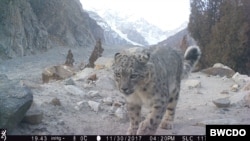Wildlife experts say increased sightings of snow leopards in Pakistan’s northern mountains are promising signs that the population of one of the world’s most endangered big cats is recovering in the area due to ongoing conservation efforts.
The outbreak of the COVID-19 pandemic and ensuing economic challenges, however, are threatening to undermine the two-decade-old “successful” campaign run by the nonprofit Baltistan Wildlife Conservation and Development Organization, or BWCDO, in partnership with U.S. charities.
Around 8,000 snow leopards are believed to be left in the wild worldwide, and fewer than 400 of them are present in Pakistan, including the Gilgit-Baltistan region, where BWCDO is working with local village populations to help protect and conserve the snow leopard.
BWCDO pioneered livestock insurance schemes for villagers to compensate farmers against livestock losses resulting from attacks by snow leopards to ensure the apex predators and humans coexist in harmony.
Ghulam Muhammad, the project’s chief executive officer, said they are also working in partnership with the U.S.-based nonprofit organization, Iqra Fund, on education and awareness programs for communities in the high-altitude villages to sensitize them about protecting and conserving wildlife.
But financial support for these projects has been disrupted due to the economic impact of the coronavirus outbreak in the United States, which may prove detrimental for the conservation campaign, Muhammad told VOA.
Earlier this month, BWCDO and The White Lion Foundation, TWLF — a UK-based global wildlife charity — jointly released exceptionally rare footage of a wild snow leopard calling in the Khaplu Valley in the wilds of Pakistan’s Karakoram mountains.
“The adult male is exercising his vocal calls to establish territory and to let females know he is in the area,” said John Knight from TWLF in the press release accompanying the video.
Knight underscored the importance of what he described as “extremely unusual” footage, saying that snow leopards are by nature elusive and solitary, only coming together to mate and raise their young.
The rare video was recorded in February with high-tech field cameras set up in the area to track and monitor the wild snow leopard population in the region, Muhammad told VOA.
He said his team also spotted three of the leopards in March, describing the occurrence as an “incredible symbol of hope” for the scenic region’s biodiversity.
“A mother and two cubs, especially so late in the season, tells us that snow leopard numbers are growing and that our method of creating a means for local communities to benefit from conservation are at the very least promising, and at best, successful,” Muhammad stressed.
BWCDO is also helping villagers build predator-proof corrals to reduce snow leopard attacks and offering vaccination programs to local farmers to reduce loss of livestock through disease.
Researchers say the programs have also helped protect and conserve the population of the markhor, a large goat found in the high mountains of northern Pakistan.
This has allowed snow leopards to hunt markhor instead of descending to relatively low altitude villages to attack precious livestock and being killed in retaliation by angry villagers.
“Today, the uncertainty that accompanies COVID-19 threatens to undo all of our efforts in the region,” said Muhammad. COVID-19 is the disease caused by the coronavirus.
He said financial support for the education projects has been slashed by 80%, making the future of dozens of teachers and some 3,000 students “incredibly uncertain.”
The U.S.-based Snow Leopard Conservancy (SLC) has been a key financial supporter of BWCDO over the years and managed to fund the projects through 2020, despite economic challenges, but there is total uncertainty about what will happen next year, Muhammad noted.
Over the last decade, an average of one snow leopard a day is believed to have been killed around the world. While many die at the hands of poachers and the illegal trade, more than half are killed in retaliation for attacks on local herders’ livestock, according to TWLF.
Last week, Pakistani provincial wildlife conservationists, together with the local chapter of the World Wildlife Fund (WWF), released rare footage of Himalayan lynx hunting a markhor in the northern Chitral valley next to the Gilgit-Baltistan region.
The nocturnal hunter and highly elusive big cat is also listed as one of the world’s endangered animals.
A WWF-Pakistan statement acknowledged that the population of markhor, once nearly extinct in the area, has substantially grown due to ongoing community-based conservation actions. This has provided lynx and snow leopard with wild prey and reduced the chances of depredation of livestock, which can force locals to kill the predators in retaliation, it said.
The exact distribution and range of the lynx population in Pakistan are not known, but officials say the first-ever filming of the animal has encouraged local and foreign experts to conduct a survey in the near future.






